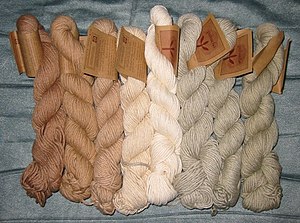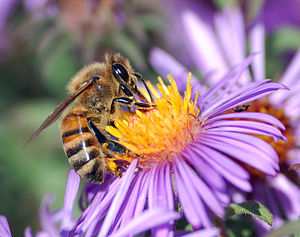 |
| Organic cotton yarn (Wikipedia) |
Aside from things we grow to feed ourselves, one of our most intensively farmed crops is the humble cotton plant, producing around 25 million tonnes of cotton every single year.
Production of cotton is limited to a few big producers, with China, Brazil, India, Pakistan, Uzbekistan and the USA accounting for over 80% of the total production.
China alone produces around 4.3 million tonnes of cotton each year, and has the highest number of cotton growers in the world.
Despite this high native production, China does not produce enough cotton to be self-sufficient, and still has to import around 418 thousand tonnes each year to meet the demand of the fashion and fabric industries in the country.
Across the globe, cotton plantations occupy over 2.5% of the arable land area available, making this one of the most widely grown crops in the world.
But what are the environmental impacts of growing cotton, and how can we make sure our fashion choices are not destroying our planet?
The Environmental Impacts
Pesticides
The use of pesticides in cotton farming has, over the years, had a major impact on the environment as well as the health of the people who work on the farms.
Cotton producers worldwide use almost £1.8 billion of pest control chemicals every year, which accounts for 10% of the world's pesticides and around 25% of the world's insecticides.
The types of pesticides used in cotton farming are among the most dangerous in the world, and many are broad spectrum organophosphates which were originally developed as toxic nerve agents during the Second World War.
Many of the chemicals in use in developing countries today have been classified as 'highly hazardous' and banned from use in the West.
Asia in particular saw a spike in the use of dangerous pesticides with the introduction of modified crop varieties, mainly because these fast growing, high yield plants were more susceptible to pests than traditional cultivars.
As pests developed a resistance to the chemicals used, so the farmers increased the use of them, until a peak in the late 1990's when the use of insecticides in some Asian countries counted for around 40% of the production costs of cotton.
The dangers of pesticides are not purely limited to the immediate environment. Because rain causes chemicals to run off from the crop fields and enter the water system, numerous complications can arise.
These can include damage to the local and extended eco system, limited local biodiversity, damage to wildlife in rivers and neighbouring biomes and even contamination of meat and milk products from animals that reside nearby.
Thankfully worldwide education programmes and alternative strategies are slowly making their way into cotton production systems.
Farmers can see the benefits of reducing pesticide use, if only for the increase in profits available from their harvests, and through a programme delivered by the UN Food and Agriculture Organisation, awareness of other methods of pest control is being raised worldwide.
Herbicides
As well as dangerous pesticides, many cotton farmers use powerful herbicides and defoliants to speed up and simplify the harvesting process. Defoliants strip leaves from the plants, leaving just the cotton bud and stem, reducing the amount of leaf litter that gets mixed in with the raw cotton.
As well as this, herbicides and fungicides may be used during the growing process to protect the cotton plant from weeds and fungi, adding to the chemical soup that cotton production is responsible for.
Fertilisers
It takes around 150g of synthetic fertilisers to grow just 500g of raw cotton. To put this in perspective, it takes around 500g of raw cotton to make one t-shirt, so you can imagine the amount of synthetic fertiliser that is entering the environment as a result of the cotton industry.
The majority of fertilisers used in cotton production worldwide are nitrogenous synthetic fertilisers, which are considered to be the most detrimental in terms of environmental impact.
These fertilisers leach from the cotton fields and run off into water systems, where they can cause problems such as contamination of river environments and harmful algal blooms.
As well as the water system, nitrogen based fertilisers are responsible for a much more concerning impact on the global ecosystem. These synthetic fertilisers are accountable for major increases in the worlds N2O emissions, a greenhouse gas which is 300 times more potent than CO2.
With the use of these fertilisers predicted to increase around 2.5 times in the next 20 - 30 years, they paint a pretty bleak picture for mitigation of climate change in the future.
Water
The damage does not end there. Cotton growing is responsible for a whole raft of further environmental issues, not least related to the diversion of water supplies to water cotton crops in developing countries.
In central and southern Asia, entire rivers were diverted to supply water to cotton crops, leading to the drying up of the Aral Sea, which once was one of the largest inland bodies of water in the world.
Other impacts
The finishing process of cotton is also incredibly environmentally damaging.
The process of spinning and weaving causes large amounts of solid waste as well as using a great deal of energy, and once the cotton is spun into a fabric, it is treated with chemicals such as pentachlorophenol to prevent rot whilst the fabric is stored.
When the material is dyed, the majority of processes will first bleach the cotton to increase the depth of colour achievable. In developing countries this is often done using a chlorine based bleach, which is incredibly harmful to the environment.
The use of chlorine has been stopped in most western countries, where they use hydrogen peroxide to bleach the fabrics instead. Although less polluting, hydrogen peroxide will only work as a bleach at temperatures of 60 degrees or above, making this process much more energy intensive.
Dyes were once made from plant products, but with the world's arable land at a premium, it is no longer possible to grow enough plants, however, there are companies producting natural plant based dyes on an industrial scale including Couleurs de Plantes in France but for the most part the clothing industry now uses petrochemicals to produce the colours they need for their cotton products.
After colouring the material, it must be thoroughly washed, resulting in a coloured, highly polluted effluent discharge.
Worldwide around 40 - 50,000 tonnes of chemical dyes go into rivers, and although western countries are taking steps to mitigate the impact of this by product, the huge textile mills in developing countries are not in an economic position to make any major changes.
The alternative: Organic Cotton & Hemp
Organic cotton is produced in completely different ways, giving consumers a real choice over how they would like their clothes to be made. Some of the benefits of organic cotton include:
- Lower carbon footprint due to manual farming practices
- No genetically modified plants used
- Grown using natural fertilisers, natural pest control methods and no defoliants
- Removal of contaminants like lead, formaldehyde, heavy metals, lead and amines from the production process, and strict testing to ensure none are present in the final products
- Safer working environments for cotton farmers and their families
- More profitable farming through reduced use of expensive chemicals
- Eco friendly processing and finishing that reduces toxic pollutants entering the eco system
Organic cotton is made to be kind to the environment and to your skin, so if you suffer with allergies or eczema, you will positively benefit from the lack of chemicals and irritants in organic cotton.
Even if you do not have sensitive skin, organic cotton feels much nicer against your skin and by choosing to purchase organic, you are showing your support for more environmentally conscious, ethical practices in the industry.
- Hemp is a wonder fibre it is the longest and strongest plant fiber and will row with very little water (about 1/20th the amount of water used to grow and process cotton.) Additionally, it is very resilient and will grow without the use of pesticides and herbicides
- Hemp has four times the strength of cotton so it won't weaken when washed
- Hemp has been in use for nearly 2000 years (since 770 AD) and used for a variety of products including sails, rope, paper, books and clothing
- Hemp is anti-fungal and filters UV light, so is good for your skin
- Hemp is also a porous fibre which allows it to breathe. The result is you are cool in the summer and warmer in cool weather
- Hemp is more water resistant than cotton and keeps your body dry as it wicks away moisture quickly
- Hemp will also retain colour better than any other fibre and resist fading
When we consider the huge benefits of switching to organic cotton and hemp as a staple for textile and clothing needs it is worth considering seeking out and supporting companies and manufacturers who are endeavouring to produce items that are good for the environment and thus good for the whole of mankind and their future.
Cock & Bull Menswear is a sustainable UK based menswear manufacturer and retailer producing desirable, wearable wardrobe staples that can be depended upon season after season.
The focus is on "beautiful garments to be cherished rather than mass consumption" and are produced in limited editions.
Inspired by contemporary culture, politics and art with a strong British flavour the garments are produced in the UK and capture the spirit, timelessness, quality and durability of old world charm while also encompassing a modern aspect.
Visit Cock & Bull Menswear to view their range of organic cotton underwear, tweed flat caps, organic cotton shirts and more.
Article Source: http://EzineArticles.com/?expert=Andii_Lindsay
http://EzineArticles.com/?The-Environmental-Impact-of-Cotton-Production:-A-Case-for-Organic-Cotton-and-Organic-Hemp&id=7733463






